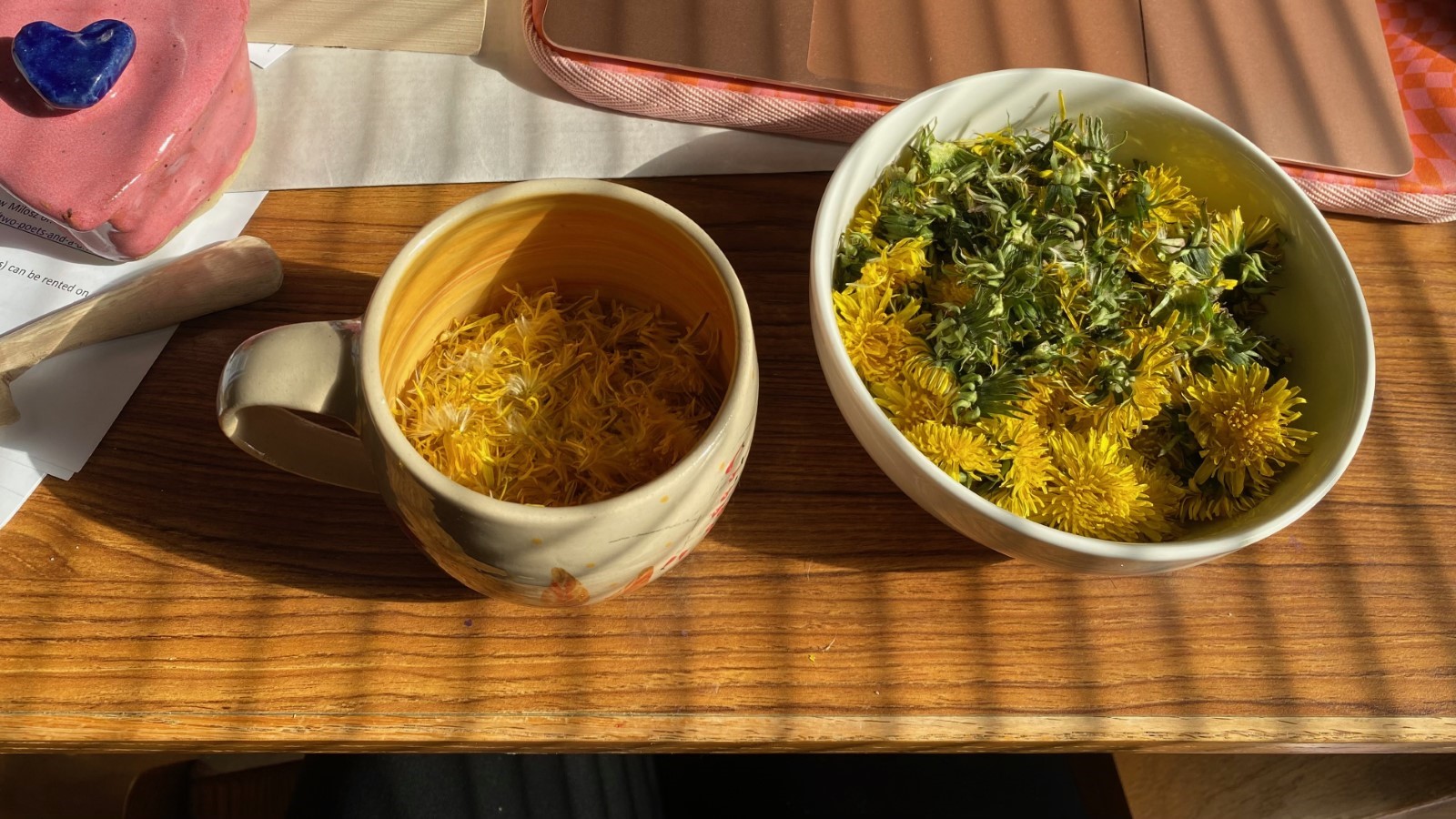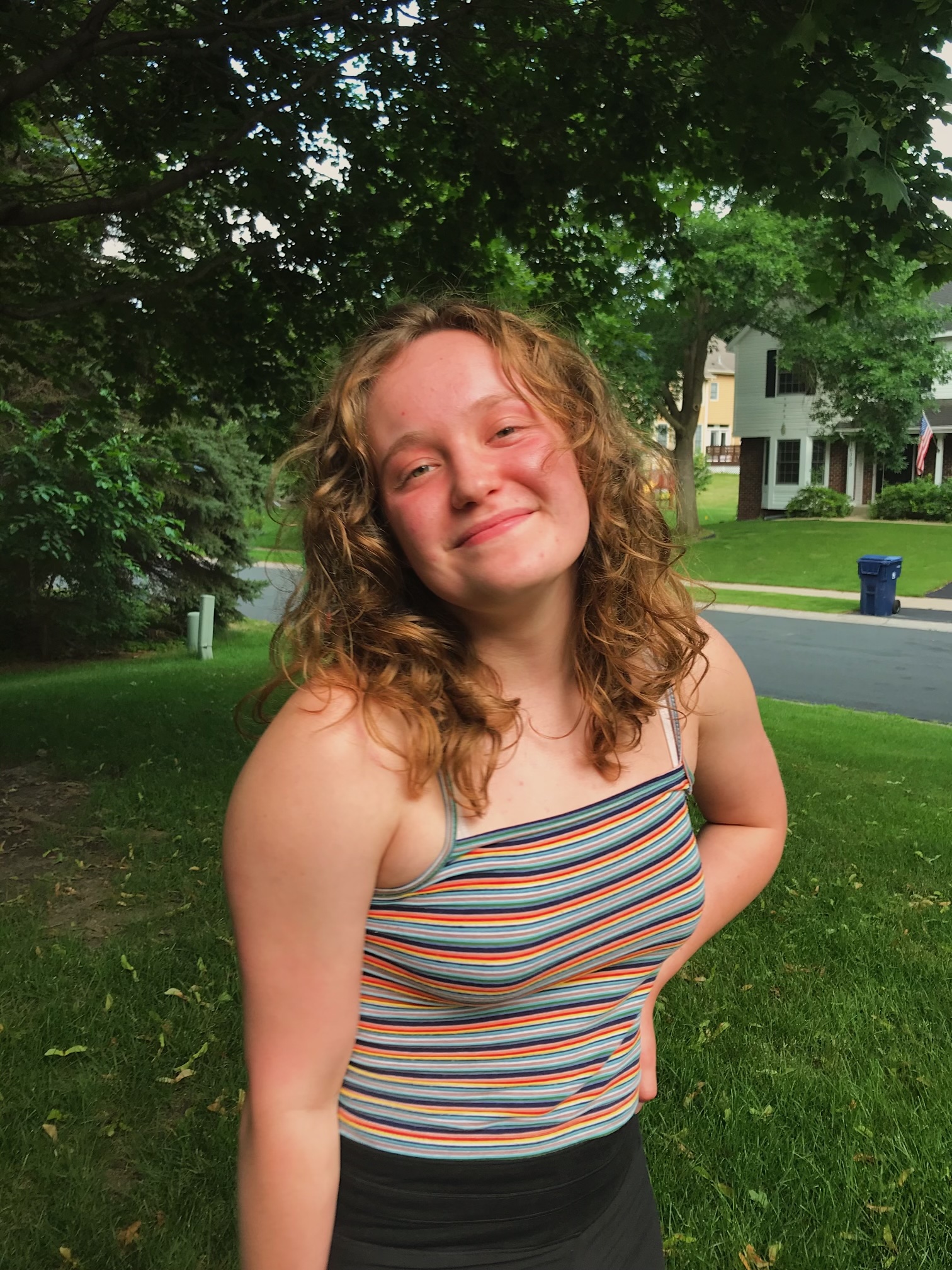“Going into a grocery store is convenient. You know, you just go to one spot, and it has what you need, and you pay money for it. But it’s also lacking in connection. We, as humans, and all life on the planet are all interdependent. I think there’s a lot of heartbreak and hard feelings around our disconnection from the surrounding landscape.”
-- Maria Wesserle
Working in a grocery store deepened the already established way that I related to food. In the year before college, I spent 40 hours of my week at an extraordinarily average one in the suburbs of Minneapolis. It featured a bakery with half-decent treats, a deli with extremely overpriced meats that they cut right in front of you, big “sale” signs hanging from any place they could be, and aisles upon aisles of food, household goods, and other items. Everything was situated underneath bright fluorescent lights that lined the warehouse-like ceilings. When I’d push my way through the big swinging doors to the back storage section of the store, my eyes would rejoice at the significant dimming of the lights. In the back of the store, industrial shelving reached all the way from the cement floor to the high ceilings, holding the surplus of every product that was out on the floor. It wasn’t just one or two extra cans of green beans sitting on a shelf; rather it was dozens of full cases, each containing upwards of 30 cans. A forklift was parked in the corner in case any of these cases needed to be taken down.
Grocery stores and mass food production have cultivated a certain worldview around food, one that separates people from their food sources. The mass harvesting, processing, transporting, packaging, and advertising systems anonymize food. They’ve been embedded so deeply in our collective consciousness that alternatives can be impractical and seem unthinkable, even to the extent that people will call foraging unsustainable. Maria Wesserle, a Minneapolis-based forager with whom I had a conversation, explained encounters where “people think foraging is unsustainable or that it’s hurting the environment or that you’re taking food away from other animals. And I’m sort of like, well, where do you think your food is coming from?”
I certainly don’t know where my food is coming from. I grew up, like nearly everyone else of my age in the United States, almost exclusively on grocery store food. It’s what has always been easiest—when your day is filled with work, school, and other time-consuming activities, and when grocery stores are so omnipresent and much of the population relies on them. This has fed my skepticism about methods of obtaining food that don’t involve grocery stores. Gathering plants, nuts, berries, other fruits, mushrooms, and other edible resources outside turns on some alarm bells. How can I be sure they’re safe? What if I accidentally ingest something harmful? How can food be free? Where would I even start looking? As it turns out, plenty of people maneuver their way around these concerns and find ways to forage for wild food sources.
I sat in Jordan Scheibel’s front yard on a fold out chair, smelling the smoke coming off boiling maple tree sap. Jordan, a forager, followed a pathway to the practice that began as part of his other activities, meditation and farming. In these settings, he met people who foraged and became interested in it himself. He emphasizes the power of forming relationships with the natural world: knowing plants by their name, studying when they are best to harvest, and tending to the Earth in a compassionate way. Positioning humans as an integral part of nature helps combat harmful attitudes that equate humans to a plague and work to separate humans from the wild. In Jordan’s eyes, foraging is a way to reduce the alienation people feel from nature.
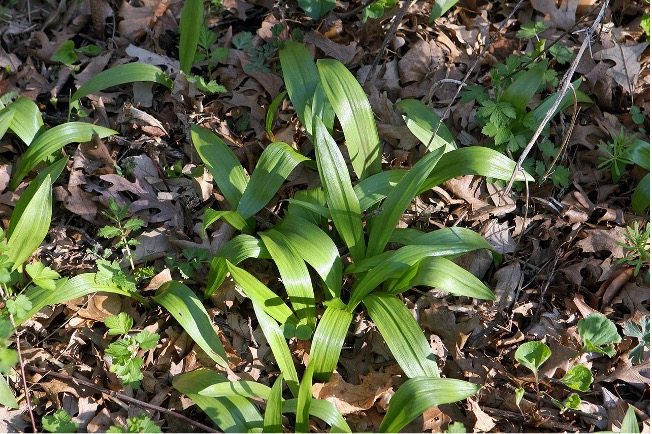
Ramps in a forest. Photo courtesy of Jon Andelson.
At the beginning of his foraging experience, Jordan tried everything he came across. He felt that showing an interest in everything gave foraging a less extractive effect. The COVID-19 lockdown was a turning point for him in his practice of foraging. Rather than going to a grocery store for food, he’d forage in local parks to avoid potential exposure and the general hassle. Over time, he narrowed his hunt to specific plants that he preferred to forage because they were easy to find, tasted good, and grew abundantly in the area. From this initial experience he developed a set of rules that still guide him today. If a plant is a weed, it can be picked with no limitations. For native plants, Jordan limits himself to taking no more than 10 percent of the plants of that species growing in a given area. His commonly foraged items include early greens (curly dock, wild onions, nettles, dandelions, ramps), mushrooms (oyster and morels), and fruits (wild plums, blackberries, apples, juneberries). He also taps trees for sap and boils it into syrup.
He hands me a mug and gestures for me to dip it into the vat of boiling sap for a taste. It’s hot and tastes like water with plenty of sugar dissolved in it.
A few weeks after the sap boiling with Jordan, I had a conversation with Stephanie Snow, another local forager. Her background in foraging came from her family and their Meskwaki heritage. Her foraging is centered around Meskwaki beliefs in the inherent power and interrelatedness of all things: that no thing is better or worse than another thing. These tenets inform her feeling of gratitude towards all food sources.
“Always remember to say thank you to the nutrition you’re asking to be in your body,” she says. “That all comes with that process when I go out to forage as well. Or even to shop. That sounds crazy, but if you go into a grocery store, you’re still selecting plants or animal products that you want to consume. No matter what we’re putting in our bodies, there should be some acknowledgment of that.”
Throughout her life, Stephanie and her family have foraged for mushrooms, gooseberries, black raspberries, plums, cherries, and walnuts. It’s a practice that she was taught as a child and has now passed on to her own children. While trying to practice ethical and sustainable methods of food consumption, Stephanie also acknowledges the system we currently live in. “Capitalism requires us to have an income and requires us to utilize certain things. You could look at a grocery store as a tool.” She explained that her family supplements their foraged and hunted food with ethical grocery store items, ones that have a commitment to transparent production processes void of chemicals or preservatives.
Not only does the modern grocery-store-based system erode foraging abilities in these more obvious ways, it also does so in more subtle ways. Responding to my question about possible downsides to foraging, Stephanie explained that the industrial food production systems are continually doing ecological damage to Iowa’s landscape that makes foraging less feasible. Industrial agriculture degrades topsoil and hurts the crops she tries to plant, hindering their growth, eroding riverbanks, contaminating the water and fish who live in it, clearing the forest and eliminating plant diversity—all of these practices narrow food sources for animals and humans alike, and the fluctuating temperatures brought about by climate change either shorten or shift harvesting timelines.
After talking with these people with great foraging experience and knowledge, I found myself inspired to go out and try it. I kept promising myself that when the other tensions in my life let up a little, I’d take everything I learned from these people and dedicate an afternoon to this pursuit. I never found that afternoon, though.
One day, I was walking along a sidewalk through my campus, gazing at the plants that peeked over the cement. It was finally nice out, and dandelions had begun to pop up. I’d see one here and one over there, then a group of three and another alone. I thought of Jordan’s foraging for dandelions and felt a pang of guilt that I still had not taken the time to go out and do it. It took several moments before it dawned on me: foraging doesn’t need to happen in a space sequestered from the rest of my life, it can happen as I’m living my life. I imagined the plants that I mindlessly walked by everyday were almost laughing at my insistence on setting aside specific time in a specific space for this practice. Sure, having those guidelines can make the foraging process more successful, but I was so set on them that I was missing the more integrated ways I could already be doing it.
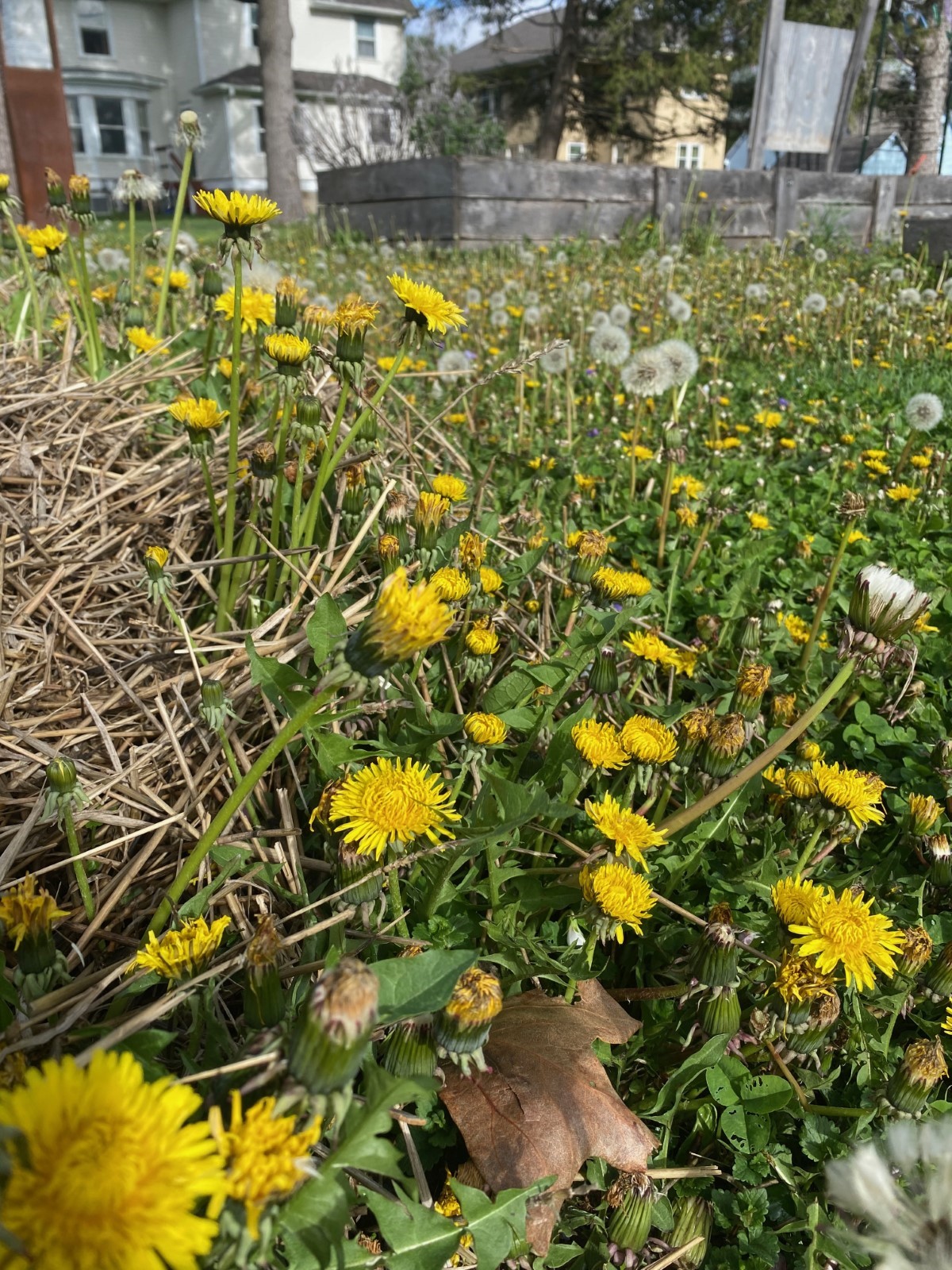
Dandelions in the Grinnell College garden. Photo courtesy of Kailee Shermak.
During my conversation with Maria Wesserle, she’d hinted at the spontaneity that can occur in the practice. I’d set out with a list of questions to ask anyone I was interviewing, including “How do you go out to forage?” People gave me answers about preparations for those chunks of time they have dedicated to it: about what to bring, what to look for, and how to store it during transport. Part of Maria’s answer differed though. After explaining her typical routine for dedicated foraging outings, she said, “sometimes I’m just out and about doing something else and then I’m like oh my god there’s a bunch of black walnuts or juneberries, or Kentucky coffeetree. So, I do like to carry some cotton and linen bags just in case I come across something that I want to pick, so I can do it.” She rattled off a list of the plants she might come across, and though I listened intently I had no idea what any of the food items she was naming were. “We’re all inherently connected to our surrounding land. But you know a lot of people are alienated from that or don’t really realize the connection,” she explained. This alienation from natural food sources blinds most people to what’s really in front of them. It’s why I see dandelions as weeds rather than as food and it’s why I can’t identify any of the plants, nuts, or berries Maria named.
We live inside a system that constantly reinforces mass food production. It’s so ubiquitous that we may not even see the ways in which we could start to get out from under it. Dandelions are weeds that need to be pulled and then thrown into the yard waste bin to be picked up on Fridays, not food that could be prepared. My relation to these plants and wild food sources has started to undergo a reorientation because of the conversations I’ve had with people who situate food and themselves differently than I do. This has revealed new meanings of the things I encounter on a daily basis, like the dandelions on the edge of the sidewalk. It’s a fundamental shift in how I approach other food sources as well, like Costco, my local grocery store, and my college dining hall.
This time, though, dandelions will be food. On a mild spring day, I biked over to the Grinnell College garden to gather a bundle of them to boil into syrup. I had been warned about the abundance of dandelions in the garden, but the dense clustering of bright yellow flowers still managed to surprise me. In between every established wooden planter box were bunches of them, most still yellow with a few already into the next wispy stage of their existence. I started at the edge of the garden, picking them by their stems and stashing them into my left hand. As I grasped each one, I could feel the difference in the circumference and hollowness of their stalks.
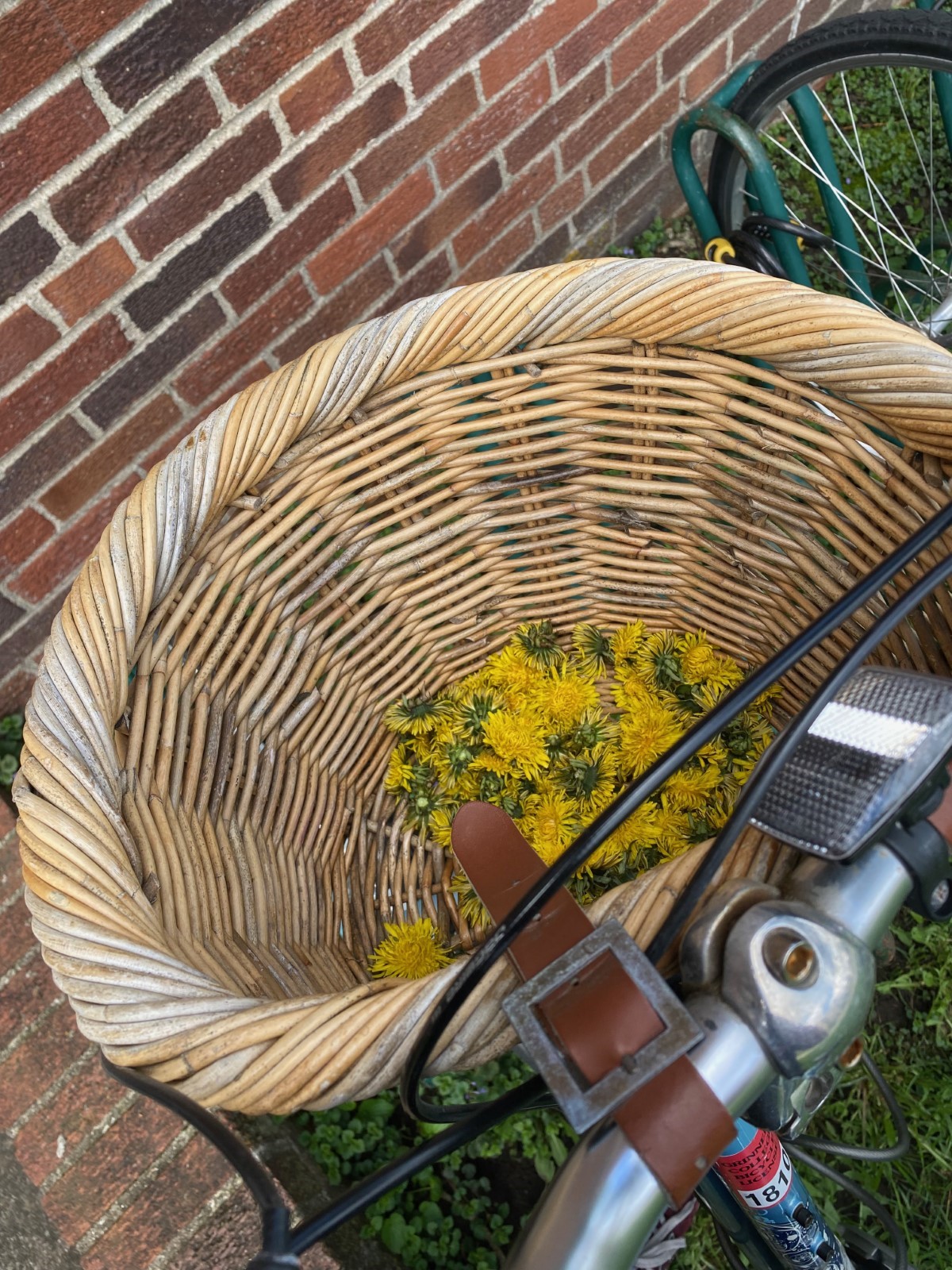
Dandelions in a bike basket. Photo courtesy of Kailee Shermak.
I had gathered as many stems as I could hold, and my palms were sticky with dandelion goo. It seemed like a good time to move on to my next task: picking only the yellow petals from the plant. The process started slow and tedious, severing the stem from the flower with my nail and carefully pulling the petals out, but after a dozen or so I’d figured out a rhythm to the movements. Each flower added another layer of brown coloring to my fingertips, proving I’d truly done the work. After the final flower was processed, I dropped the clump of loose petals into a bowl of water to soak for the next day.
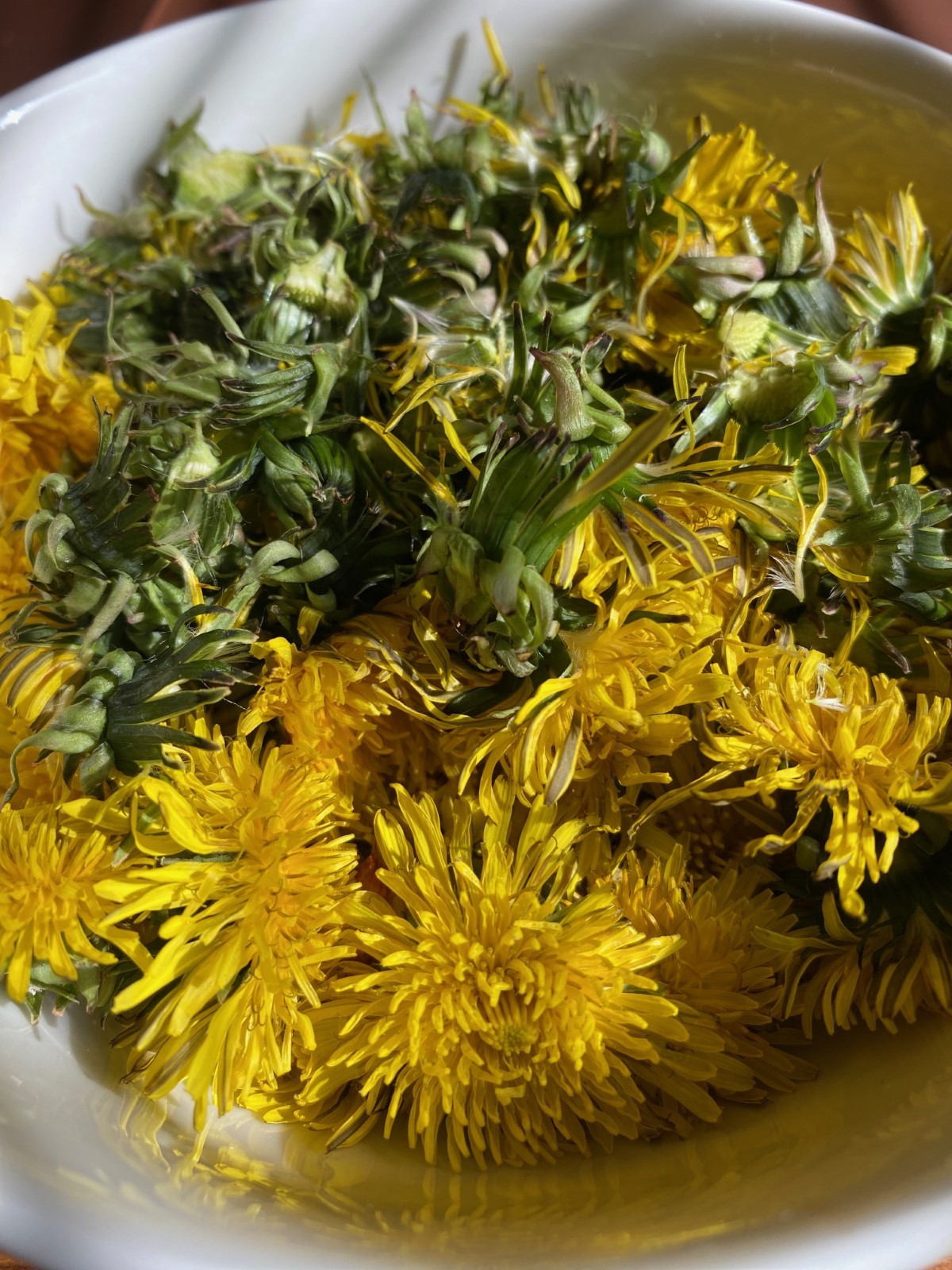
Dandelion flowers in a bowl. Photo courtesy of Kailee Shermak.
The next morning, a pot sat on the stove waiting for whatever I decided to dump in it. Thinking along the lines of “how hard can it be to make syrup,” I had opted to not revisit my instructions and jump right into the process. I poured the petals and their accompanying water into the pot and let a generous amount of sugar fall out of the bag into it as well. After a few minutes of stirring, I realized the petals were not supposed to be in this final mixture. I hurried to fish out as much as I could with my tea strainer before the sugar water got too hot. I’d have to be ok with slightly chunky dandelion syrup.
It bubbled and I stirred, trying to be attentive to its viscosity. I had no idea how to tell if syrup was done or not, but it seemed done so off to the fridge it went until its big unveiling. Each time I went back to my room that day, I’d open the fridge door and check on it, sometimes even wiggling the bowl around to check how much it looked like actual syrup. It did not. Back into the pot and onto the stove it went. It bubbled again and I stirred again, adding more and more sugar until I was sure it would behave like syrup. Finally, I held a bowl of something that could recreate the slow drip of syrup off my knife during a pancake breakfast. The only question that remained was taste. My answer after deciding to eat a plain spoonful was that it reminded me greatly of honey. There was a light and sweet weight to it, with nutty flavors hidden beneath that.
Word had spread among my friends, mostly because I told them, that I had made this mysterious dandelion syrup. During a conversation with one of them, I’d mentioned feeling overwhelmed and inadequate, which she immediately refuted. “You’re on top of everything, Kailee. You made dandelion syrup,” was her reasoning. It reminded me of the thoughts that held me back from foraging in the first place. The ones that said I needed to have everything together and organized before I undertook this daunting task. In reality, picking dandelion petals and boiling them into a syrup did not take more than three hours of my life. I didn’t find the perfect afternoon to wander into the woods and fully take in the natural world. I didn’t have an exhaustive bank of information about plants and preparation processes in my mind, besides baseline safety guidelines. I didn’t use any special tools beyond a pot, spoon, and tea strainer. Foraging, in practice, has a surprisingly low barrier to entry. The plants are all around us, but I’ve seen in my own thoughts and others’ commentaries that it remains an elusive concept. A concept reserved for people who have it all together and perfect. The moments where I found success throughout this process were the ones where I stopped waiting around for the perfect conditions and, rather, just did it.
